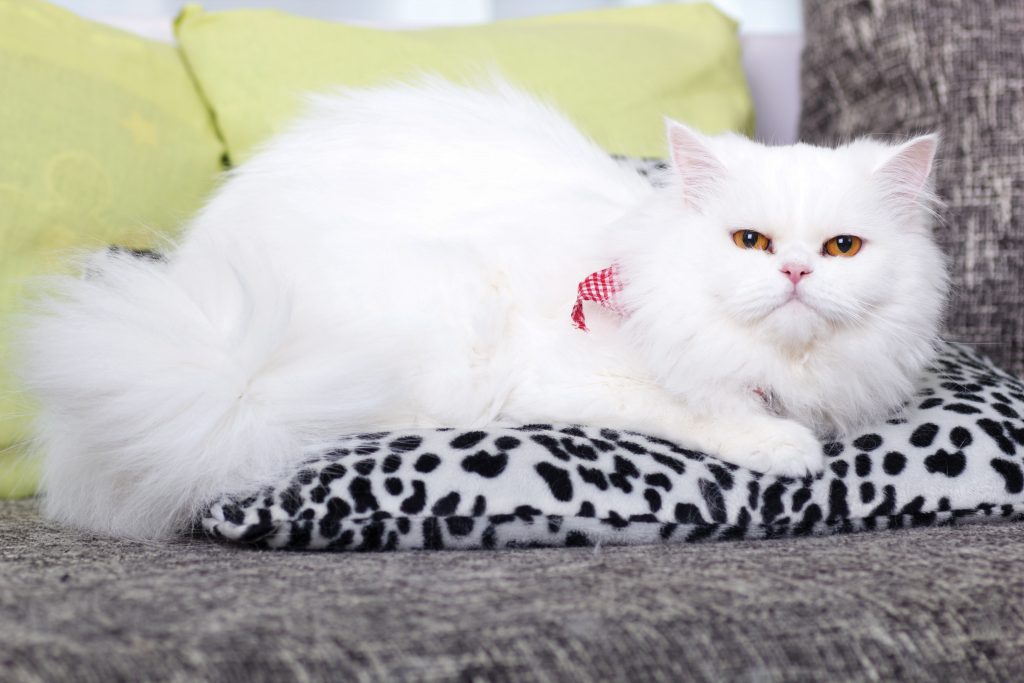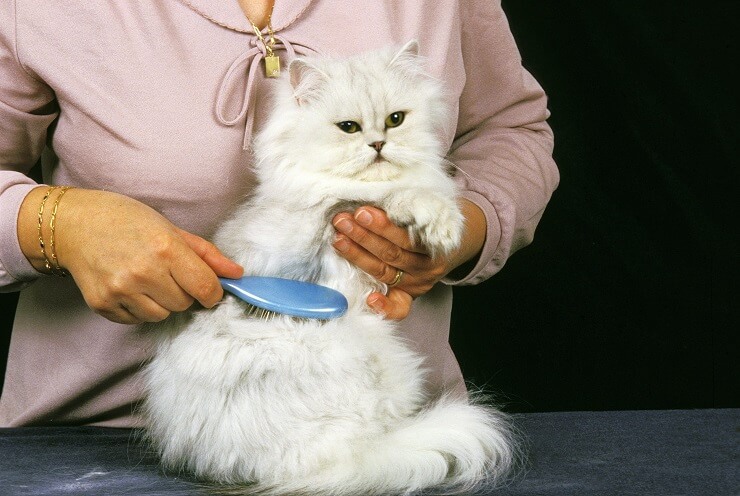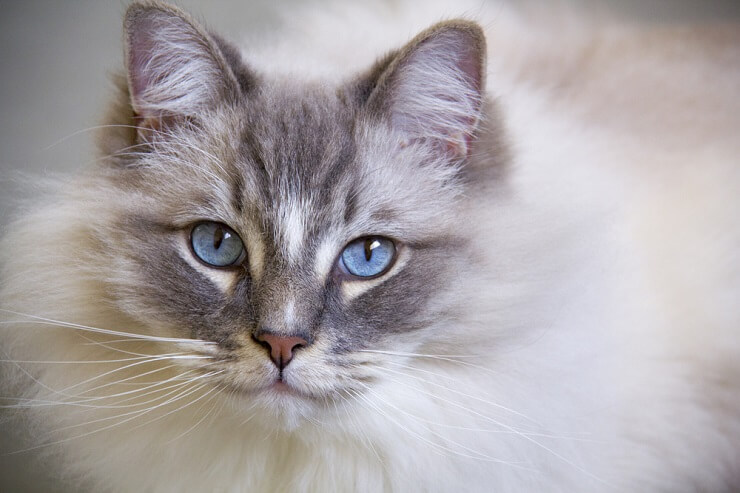Persian Cat Grooming: The Complete Guide
This page contains affiliate links. We may earn money or products from the companies mentioned in this post through our independently chosen links, which earn us a commission. Learn More

Many cat lovers would love to adopt an adorable Persian cat into their family. However, some people can be understandably reluctant to take home one of these fluffy felines due to the work involved in grooming their magnificent coats.
It may seem like keeping this breed’s coat in good condition will either be expensive, with regular trips to the groomer, or time-consuming and difficult for you.
While it is true that grooming your Persian pet can be time-consuming, it can also be a fantastic bonding experience for you and your cat.
So, let’s take a look at exactly what is involved so you can decide whether or not you’re up to the task with our complete guide to Persian cat grooming.
Do You Need To Groom Your Persian Cat?
One of the great things about having a cat as a pet is they tend to clean themselves. Anyone who has cared for a cat for any period of time might assume that self-grooming is one of their favorite pastimes.
While Persians do groom themselves, they sometimes need help to keep their coat in order because it is so thick, long, and luscious. It easily picks up dirt and debris, and can become matted and knotted.
If you don’t learn how to groom your cat and commit to regular grooming, you might find them coughing up excessive hairballs and leaving behind significant quantities of their hair around the house. Plus, their long and luxurious fur is prone to developing tangled mats.
If they do develop knots or matting in their coat, the skin underneath can get infected.
In reality, it doesn’t take much effort to keep your long-haired cat well-groomed, especially as they tend to be house cats that prefer to stay indoors. Still, regular grooming will keep your cat happy, and it can be an important bonding experience for you both.
Read more about the characteristics of the Persian cat breed.
Daily Brushing
Properly caring for your Persian’s coat should start with daily brushing. Regular brushing is essential to keep their coat free of knots, brush out excess hair they might otherwise shed, and also remove any food or other debris that might have become caught in their coat.
It is best to use a sturdy, metal, wide-toothed comb. Avoid plastic options, as these can create static electricity that can shock your cat, making the grooming experience quite unpleasant for them.
Slowly and gently work through any knots you might find, being careful not to pull on your cat’s hair. Pay close attention to the belly, armpits, and around the ears, as this is where they tend to have the most trouble.
Trimming
Some pet owners trim their cat’s hair occasionally as part of the brushing process. You might just want to give a quick trim to areas that need it every few months. Plus, you can easily cut out any mats you might have missed.
Overall, though, for a Persian cat, haircuts are not required regularly. You may only need to do it once a year at the start of summer to help them keep cool in the hotter months.
This may also be the one time of year you splurge on a trip to the cat groomer. While nipping off the ends of their long hairs isn’t challenging, you might also want to cut their hair quite a bit shorter around sensitive areas, such as around their anus to prevent feces from getting caught in the long hair.
Some owners shave their Persians to give them certain haircuts or designs in their fur, but this is not necessary or particularly comfortable for the cat.
Your feline friend probably won’t enjoy the process, and if they do decide to make a run for it, you could accidentally cut them. This type of grooming is best left to the experts.
General Grooming

Bathing
In addition to combing your cat’s fur, you will occasionally need to give your Persian a bath so you can shampoo their hair. How often they will need a bath depends on their lifestyle and how dirty they are prone to getting. For example, active and lively kittens will probably need bathing more often than lazier, older cats.
You don’t want to bathe them too often, though, as it can strip the natural oils from their coat. As a general rule, a maximum of once a month is probably best, and you should wait no more than three months between baths.
Bathing your cat can be a difficult process. Cats generally don’t like baths, so they are likely to run for the hills at the first sign of water. It’s a good idea to put some time and effort into getting them accustomed to the water from a young age so they are a little more tranquil at bath times, though they will likely never feel 100% comfortable in the water.
First, fill a basin or your bathtub with warm water, and have a showerhead or a jug you can rinse them with on hand as well.
Next, slowly soak your cat with warm water until they are wet all over so you can lather them with shampoo. Avoid areas like the ears, nose, and mouth.
Be sure to choose a special cat shampoo that is pH neutral. Don’t use your own shampoo, as it is too acidic for cats and can irritate their skin.
Lather in a small amount of shampoo, and then rinse the cat’s body thoroughly. You might want to go through the process of shampooing more than once depending on how dirty your cat’s coat is.
Conditioning is an optional follow-up, which can be great for Persians if they have the patience to stay in the water for the process. Choose a conditioner that you rinse out rather than leave in.
Throughout the shampooing and conditioning process, make sure you don’t let the product get in your cat’s eyes or mouth, as this will be unpleasant and painful for them.
Also, don’t let any water get into their ears. You might want to put cotton balls in their ears to protect them from the water if they aren’t good at staying still while in the bath.
Finally, make sure you have two towels on hand to dry them off. You’ll use the first towel to absorb most of the water and the second to get them thoroughly dry. You might also want to finish off with a hairdryer on a low, cool setting, though the sound and the strength of the wind can be frightening for your cat.
Comb through their hair to remove any remaining knots or other debris when their coat is almost completely dry.
The Verdict
There is no denying Persian cats are a lot more work than other cats when it comes to grooming. Most cats groom themselves, and they typically only need you to intervene if they become very dirty.
Persian cats, however, need brushing daily and should be bathed once every 1-3 months. Their long, thick coats require more maintenance than the coats of most shorthair cats.
While this sounds like a lot of work, many pet parents consider regular grooming a bonding experience. Just be sure to prepare yourself for a few battle wounds along the way.
Do you have a Persian cat? How do you groom them? Share your experiences with the community in the comments section or tag us on your favorite social media channel.
Frequently Asked Questions
How many times should a Persian cat take a bath?
How often your Persian cat needs a bath depends on their lifestyle and how dirty they get. As a general rule, you should bathe your cat no more than once a month and no less than once every three months.
How do you bathe a Persian cat?
The process of bathing your Persian cat is very similar to the process of giving a dog a bath at home. The main difference is that cats usually hate water, so they are much more likely than dogs to bolt mid-bathtime. Do as much as you can to make them comfortable, such as keeping the water at a comfortable temperature and keeping shampoo and other products out of their eyes and ears.
How do you groom a Persian cat at home?
Grooming your Persian cat at home generally means daily brushing and a bath once every one to three months. You can also trim their hair as necessary. Your cat will probably only need a major trim once per year at the start of every summer. For this, you might want to visit a professional groomer, as no one enjoys a bad haircut.
How do you dry a Persian cat after a bath?
After their bath, dry your Persian cat thoroughly by using two towels. Use the first towel to soak up most of the water, and the second towel to give them a good rub down to get them completely dry. You should comb their hair once they are almost completely dry. You can also finish off with a hairdryer on a low, cool setting, but it is not necessary because most cats find the sound of the hairdryer to be stressful.



